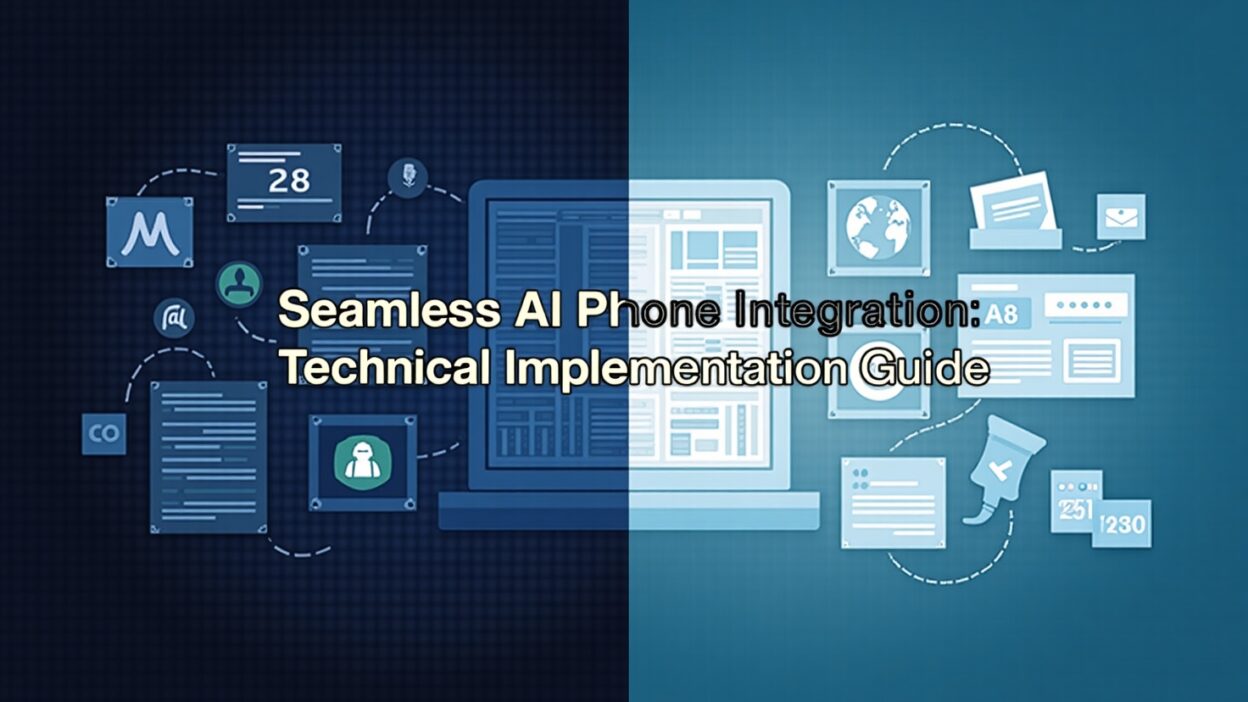Modern businesses require sophisticated communication systems that can handle complex customer interactions while providing intelligent automation and data-driven insights. An AI phone system guide is key for businesses wanting to upgrade old phone systems. It helps create smart tools that improve customer service and efficiency.
Table of Contents
Adding AI to old phone systems is complex. It needs good planning, tech skills, and knowledge of both old and new tools. This guide offers a step-by-step plan—from early setup to ongoing improvements.
Successful AI phone system integration requires more than simply connecting new software to existing hardware. It demands a holistic approach that considers network architecture, data flow, security protocols, and user experience design. Organizations that use a clear AI phone system guide avoid mistakes. They can launch smoothly and gain quick benefits while preparing to grow.
Understanding AI Phone System Integration Architecture
Core Components of AI Phone Systems
An effective AI phone system integration guide must first address the fundamental architecture components that enable intelligent communication processing. Modern AI phone systems consist of several interconnected layers work together. It provide call handling, natural language processing, and automated decision-making capabilities.
The base layer includes traditional phone systems like PBX, SIP trunks, and VoIP networks. These components handle basic call routing, connection management, and audio transmission. An AI phone system guide should make sure the basic setup is ready and optimized for AI tasks.
The intelligence layer encompasses artificial intelligence engines, machine learning models, natural language processing systems, and automated decision trees. This layer processes incoming calls, analyzes speech patterns, understands customer intent, and determines appropriate responses or routing decisions. Proper integration of this layer requires careful attention to API connectivity, data formats, and real-time processing capabilities.
Latency considerations are particularly critical in AI phone system integration scenarios. Real-time conversation analysis and response generation require sub-100-millisecond processing times to maintain natural conversation flow. Network architects must design low-latency paths between AI processing systems and telephony infrastructure to ensure optimal performance.
Network Requirements and Considerations
A thorough AI phone system integration guide must address the network infrastructure requirements that support AI-enhanced telephony operations. AI phone systems create more data traffic than traditional ones. Because they process audio in real time, run machine learning, and sync with cloud services.
Bandwidth requirements for AI phone system integration typically exceed traditional telephony needs by 300-500%. It depends on the complexity of AI features and the number of concurrent calls. Organizations must evaluate their current network capacity. They must plan for substantial upgrades to support AI processing workloads, especially during peak usage periods.
Pre-Integration Planning and Assessment
Infrastructure Evaluation Framework
Before beginning any AI phone system integration project, organizations must conduct comprehensive infrastructure assessments that identify current capabilities, limitations, and upgrade requirements. This evaluation forms the foundation of any effective AI phone system integration guide and determines the complexity and cost of the implementation project.
Legacy system compatibility represents one of the most significant challenges in AI phone system integration. Many organizations operate aging PBX systems, proprietary telephony hardware, and custom-built communication applications that may not support modern integration protocols. A detailed compatibility assessment helps identify which systems require replacement, upgrade, or custom integration development.
Security infrastructure evaluation is equally critical in AI phone system integration planning. AI systems process sensitive customer communications, personal information, and business data that require robust security controls. Organizations must assess their current security posture and identify additional controls needed to protect AI-enhanced communication systems.
Data Flow and Integration Points
Successful AI phone system integration requires careful mapping of data flows between existing systems and new AI components. This mapping exercise identifies all integration points, data formats, synchronization requirements, and potential bottlenecks that could impact system performance.
Customer relationship management (CRM) systems often serve as primary data sources for AI phone systems, providing customer history, preferences, and contextual information that enables personalized interactions. The AI phone system integration guide must specify how this data flows between systems, what formatting or transformation is required, and how real-time synchronization is maintained.
Call detail records, conversation transcripts, and AI-generated insights must flow back to business systems for analysis, reporting, and continuous improvement. This reverse data flow is often overlooked in AI phone system integration planning but is essential for measuring success and optimizing performance over time.
Technical Implementation Strategies
API Integration and Middleware Solutions
Modern AI phone system integration relies heavily on Application Programming Interface (API) connectivity to enable seamless communication between different system components. A comprehensive AI phone system integration guide must provide detailed specifications for API implementation, including authentication protocols, data formats, error handling, and performance optimization techniques.
RESTful APIs have become the standard for AI phone system integration due to their simplicity, scalability, and broad compatibility with existing business systems. However, real-time communication requirements may necessitate WebSocket connections or other persistent communication protocols for low-latency data exchange.
Middleware solutions play a crucial role in complex AI phone system integration scenarios where multiple legacy systems must communicate with modern AI platforms. These middleware components handle data transformation, protocol translation, and routing logic that enables seamless integration without requiring extensive modifications to existing systems.
Database Integration and Data Management
AI phone systems generate vast amounts of structured and unstructured data that must be properly stored, indexed, and made accessible for analysis and machine learning operations. Database integration represents a critical component of any AI phone system integration guide, requiring careful consideration of performance, scalability, and data governance requirements.
Traditional relational databases may struggle with the volume and variety of data generated by AI phone systems. Many organizations implement hybrid data architectures that combine traditional databases for structured transactional data with NoSQL solutions for unstructured conversation data and time-series analytics platforms for performance monitoring.
Data synchronization between AI phone systems and existing business databases requires robust change data capture mechanisms that ensure consistency across all systems. The AI phone system integration guide must specify how data conflicts are resolved, how synchronization failures are handled, and how data integrity is maintained during system outages or maintenance windows.
Security and Compliance Considerations
Encryption and Access Controls
Security represents a paramount concern in AI phone system integration projects due to the sensitive nature of customer communications and the potential for AI systems to access vast amounts of business data. A comprehensive AI phone system integration guide must address encryption requirements, access control mechanisms, and compliance obligations that govern AI-enhanced communication systems.
End-to-end encryption protects customer conversations throughout the entire AI phone system integration architecture, from initial call capture through AI processing and final storage. This encryption must be implemented without significantly impacting system performance or introducing latency that degrades customer experience.
Role-based access controls ensure that AI phone system integration maintains appropriate security boundaries between different user groups, system components, and data categories. These controls must be granular enough to support complex organizational structures while remaining simple enough to manage effectively at scale.
Regulatory Compliance Framework
AI phone system integration must comply with numerous regulatory requirements that vary by industry, geography, and customer type. Financial services organizations must consider PCI DSS requirements, healthcare providers must address HIPAA compliance, and companies operating in Europe must ensure GDPR compliance throughout their AI phone system integration.
Data retention policies become particularly complex in AI phone system integration scenarios where conversation data, AI-generated insights, and customer interaction records may have different retention requirements. Organizations must implement automated data lifecycle management systems that ensure compliance while maintaining the data needed for AI system training and improvement.
Audit trail requirements necessitate comprehensive logging and monitoring capabilities throughout the AI phone system integration architecture. These audit systems must capture all system interactions, data access events, and AI decision-making processes in formats that support regulatory review and compliance validation.
Testing and Quality Assurance Protocols
Integration Testing Methodologies
Thorough testing represents a critical success factor in AI phone system integration projects due to the complexity of interactions between multiple system components and the real-time nature of telephony operations. A comprehensive AI phone system integration guide must specify testing methodologies that validate both technical functionality and business process effectiveness.
Unit testing focuses on individual AI phone system integration components, validating that APIs function correctly, data transformations produce expected results, and AI models generate appropriate responses under various input conditions. These tests must be automated and integrated into continuous integration pipelines to ensure consistent quality throughout the development process.
Integration testing validates the interactions between different system components, ensuring that data flows correctly between telephony infrastructure, AI processing systems, and business applications. This testing must simulate realistic load conditions and include failure scenarios to validate system resilience and error handling capabilities.
Performance Validation and Optimization
Performance testing becomes particularly critical in AI phone system integration due to real-time processing requirements and the potential for AI workloads to impact overall system responsiveness. Load testing must simulate peak usage conditions while monitoring system performance across all integration points.
Response time validation ensures that AI phone system integration maintains acceptable performance levels during normal and peak usage periods. This testing must measure end-to-end response times from call initiation through AI processing and final response delivery to validate that customer experience remains optimal.
Scalability testing validates that AI phone system integration can handle projected growth in call volume, feature utilization, and data processing requirements. This testing must identify performance bottlenecks and validate that the system architecture can scale appropriately as business requirements evolve.
Deployment and Go-Live Strategies
Phased Rollout Planning
Successful AI phone system integration typically requires phased deployment strategies that minimize business disruption while allowing for iterative testing and optimization. A well-structured AI phone system integration guide provides detailed rollout plans that balance speed of implementation with risk management considerations.
Pilot deployments allow organizations to validate AI phone system integration in controlled environments with limited user groups and call volumes. These pilots provide valuable feedback that can be incorporated into the broader deployment while identifying potential issues before they impact critical business operations.
Feature-based rollouts enable organizations to implement AI phone system integration capabilities incrementally, starting with basic automation features and gradually adding more sophisticated AI capabilities as users become comfortable with the new system and technical issues are resolved.
Change Management and User Adoption
Technical implementation represents only part of successful AI phone system integration. Change management strategies ensure that end users understand new capabilities, feel comfortable with AI-enhanced features, and can effectively leverage the system to improve their productivity and customer service delivery.
Training programs must address both technical aspects of AI phone system integration and the business process changes that result from AI automation. These programs should include hands-on exercises, scenario-based learning, and ongoing support resources that help users adapt to new workflows and capabilities.
Communication strategies help manage expectations and build enthusiasm for AI phone system integration while addressing concerns about job displacement or technology complexity. Regular updates, success stories, and feedback mechanisms help maintain momentum throughout the deployment process.
Post-Implementation Optimization and Maintenance
Performance Monitoring and Analytics
To keep AI phone systems successful, businesses need strong monitoring. This should track system performance, results, and user satisfaction. These monitoring systems provide the data needed for continuous optimization and help identify opportunities for additional AI capabilities.
Real-time dashboards help IT teams track the AI phone system. They can spot problems early and make sure the system meets service goals. These dashboards must provide both technical metrics and business-relevant indicators.
Analytics platforms help organizations understand how AI phone system integration impacts customer experience, operational efficiency, and business outcomes. These insights drive continuous improvement efforts and help justify additional investments in AI capabilities.
Continuous Learning and Model Updates
AI phone systems need regular updates and tuning. This keeps the models accurate and effective as business needs change. Model updating processes must balance the need for improved performance with the stability requirements of production telephony systems.
Data quality management becomes increasingly important as AI phone systems generate more interaction data and conversation insights. Organizations must set up data rules to manage training data. The data should be accurate, fair, and reflect real users. This helps the AI work properly.
Version control and rollback steps help manage updates safely. If problems come up, changes can be undone quickly. These procedures must account for the distributed nature of AI systems and the dependencies between different system components.
Read More: Calculate Your AI Phone Call ROI: Free Tool & Framework
Conclusion

Integrating AI phone systems is a complex but valuable task. It can improve communication and customer experience. Success needs good planning, solid tech setup, and regular updates to meet changing business needs.
Organizations that follow a clear AI phone system guide can avoid common mistakes. With good planning, skilled teams, and change management, they gain better customer service, smoother operations, and a stronger market position.
The future of business calls is smart systems that understand context and predict needs. AI phone systems make this possible. They help businesses grow and stay competitive.






[…] Voice biometrics AI analyzes unique vocal characteristics to verify identity through speech patterns. The technology processes voice samples like “my voice is my password” and compares them against stored voice prints automatically. […]
[…] Read More: Seamless AI Phone Integration: Technical Implementation Guide […]
[…] practices encounter specialized AI implementation expenses beyond standard deployments. HIPAA compliance validation costs $10,000-30,000 initially. Ongoing […]